- Trading
- Trading
- Markets
- Markets
- Products overview
- Forex
- Commodities
- Metals
- Indices
- Shares
- Cryptocurrencies
- Treasuries
- ETFs
- Accounts
- Accounts
- Compare our accounts
- Our spreads
- Funding & withdrawals
- Volume rebates
- Open account
- Try free demo
- Platforms & tools
- Platforms & tools
- Platforms
- Platforms
- Platforms overview
- TradingView
- MetaTrader 4
- MetaTrader 5
- MetaTrader Copy Trading
- cTrader
- cTrader copy trading
- Mobile trading platforms
- GO WebTrader
- PAMM
- Premium trading tools
- Premium trading tools
- Tools overview
- VPS
- Genesis
- Education
- Education
- Resources
- Resources
- News & analysis
- Education hub
- Economic calendar
- Earnings announcements
- Help & support
- Help & support
- About
- About
- About GO Markets
- Our awards
- Sponsorships
- Client support
- Client support
- Contact us
- FAQs
- Quick support
- Holiday trading hours
- Maintenance schedule
- Fraud and scam awareness
- Legal documents
- Trading
- Trading
- Markets
- Markets
- Products overview
- Forex
- Commodities
- Metals
- Indices
- Shares
- Cryptocurrencies
- Treasuries
- ETFs
- Accounts
- Accounts
- Compare our accounts
- Our spreads
- Funding & withdrawals
- Volume rebates
- Open account
- Try free demo
- Platforms & tools
- Platforms & tools
- Platforms
- Platforms
- Platforms overview
- TradingView
- MetaTrader 4
- MetaTrader 5
- MetaTrader Copy Trading
- cTrader
- cTrader copy trading
- Mobile trading platforms
- GO WebTrader
- PAMM
- Premium trading tools
- Premium trading tools
- Tools overview
- VPS
- Genesis
- Education
- Education
- Resources
- Resources
- News & analysis
- Education hub
- Economic calendar
- Earnings announcements
- Help & support
- Help & support
- About
- About
- About GO Markets
- Our awards
- Sponsorships
- Client support
- Client support
- Contact us
- FAQs
- Quick support
- Holiday trading hours
- Maintenance schedule
- Fraud and scam awareness
- Legal documents
- Home
- News & Analysis
- Articles
- Forex
- The Loonie – Best Performing G10 Currencies
- The Liberals won in terms of seat numbers.
- The Conservatives won 121 seats in Parliament compared with 99 in 2015 and have won the popular votes claiming 34.4% over the Liberals’ 33%.
- Bloc Quebecois was a huge win as they gained 22 seats.
- If there is a coalition between the Liberals and the NDP, there could be a much larger fiscal spending than originally expected.
- Tax cuts would also help to boost consumer spending.
News & AnalysisThe Loonie
Best Performing G10 Currencies
After a tight campaign marred by scandals, Justin Trudeau secured another term as Prime Minister. Unlike a clear win in 2015, the Prime Minister did not pass the threshold of 170 seats and will lead a minority government. The governing party will be forced to depend on other parties to pass legislation.
The voting results show deep divisions in the country:
The outcome of the election is unlikely going to drastically change the dynamics in the Canadian markets. On a broader level, there are layers of similarities between the agendas of the different political parties which will help to reduce the uncertainties that generally arises from election results. However, the Liberals governing as a minority government will rely on smaller parties to push legislation which will be challenging.
In the money markets, the Canadian dollar was trading near three-months high against its US counterpart on the Liberals win. The loonie has been on an upswing this year backed mostly by strong economic data and is currently the best performing G10 currencies:
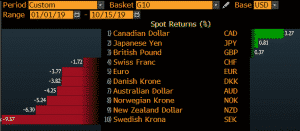
Source: Bloomberg TerminalCanada’s Economy
The Canadian economy outperformed its rivals which allowed the Bank of Canada to keep its benchmark interest rate steady at 1.75% while other central banks have cut their own rates in response to the global backdrop.
Employment
Employment rose by 54,000 in September driven by gains in full-time work while the unemployment rate declined by 0.2% to 5.5%. The growth was mostly seen in the self-employment and public sector employees.
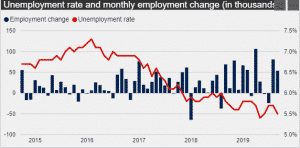
Source: Bank of CanadaWage Growth
The Average Hourly Wage Rate year-on-year in September jumped to 4.25% and marked the strongest month in a decade.
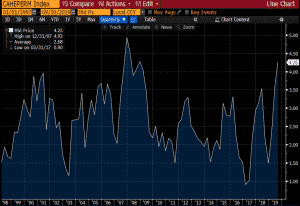
Source: Bloomberg TerminalThe Wage-common, a wage measure that the Bank of Canada uses to capture the underlying wage pressures reflecting the common trend across data sources rose to 2.7% in the second quarter in 2019.
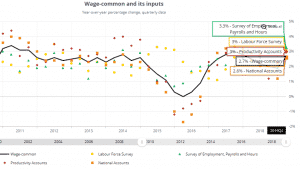
Source: Bank of CanadaInflation
The Bank of Canada aims to keep inflation at the 2% midpoint of an inflation-control target range of 1% to 3%. The recent annual inflation rate stood steady at 1.9% but fell low of market expectations of 2.1%. However, inflation remains close to or on target since March 2019.
Business Outlook Survey
The Business Outlook Survey indicator rose to 0.40 which shows a slight improvement in overall sentiment. However, due to the challenges in the energy sector, the sentiment in Prairies remain predominantly negative.
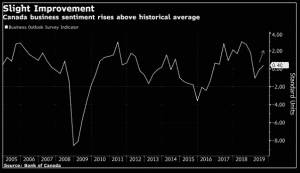
The Loonie
While major central banks have been cutting interest rates, the BoC has been reluctant to do so despite the global downturn because of the sound economic environment. The Canadian dollar has been on the rise and has retained the number 1 spot among the G10 currencies against the US dollar.
After the election, the prospects of growth-boosting fiscal policies combined with a resilient economy may keep the BoC on the sidelines.
Investors are expecting further divergence between the Fed and the BoC. While the BoC is expected to keep its interest rate on hold this year and until late 2020, the Fed is widely expected to cut rates.
In the short-term, we expect the loonie to benefit from the rate divergence and the fiscal boost. In the medium-term, the Canadian dollar may weaken as the effective implementation of the fiscal expansionary policy will lower the Canadian exchange rate.
See our introduction to forex for more information, including currency trading for beginners here.
Ready to start trading?
Disclaimer: Articles are from GO Markets analysts and contributors and are based on their independent analysis or personal experiences. Views, opinions or trading styles expressed are their own, and should not be taken as either representative of or shared by GO Markets. Advice, if any, is of a ‘general’ nature and not based on your personal objectives, financial situation or needs. Consider how appropriate the advice, if any, is to your objectives, financial situation and needs, before acting on the advice. If the advice relates to acquiring a particular financial product, you should obtain and consider the Product Disclosure Statement (PDS) and Financial Services Guide (FSG) for that product before making any decisions.
Next Article
The MACD – Useful indicator or just another pretty picture?
The MACD (or the ‘Moving Average Convergence/Divergence oscillator’ to give its full name) is one of the popular extra pieces of information we often see added to charts. The purpose of this article is to clarify what it may be telling you about market sentiment and offer a description as to how traders commonly apply this in their de...
November 3, 2019Read More >Previous Article
Quick Trading Tip #1 – Developing patience in your trading
When we first start to trade, or subsequently (as a more experienced trader) when we trade a new symbol or system we are often “excited” as we...
October 23, 2019Read More >News and Analysis
Join our mailing list to receive market news and monthly newsletters, delivered directly to our inbox.

